I have always been a Claussen Kosher Dill Pickle fan. Forever. I don’t like sweet pickles or bread and butter pickles, they just aren’t my thing. Claussen just tastes better, in my opinion, I don’t even like the shelf brand dill pickles. They are either too sweet or too tangy. That’s why I posted this Claussen pickle recipe several years ago.

Refrigerator pickles are a lot easier to make because they don’t require using the traditional canning process. That also means they can’t be stored on a shelf in the basement or in the pantry, they must live in the refrigerator.
Recipe for Claussen Pickles at Home
Last year I made some pickles with the canning method and the recipe that I used had a very high vinegar to water ratio. So they were far too vinegary for me to eat straight from the jar, which is one of my favorite things, though they were great on burgers and in potato salad!

So I started my search for a Claussen copycat. I found this one but it used apple cider vinegar. I as concerned that would create a sweet pickle, which I don’t like, even though the author of that recipe is just like me. Yuk to sweet pickles!
So I looked at the actual Claussen ingredient label and it said they used distilled white vinegar. Some of the ingredients were different too, so I decided to use the recipe that I found as a jumping off point and created my own version.
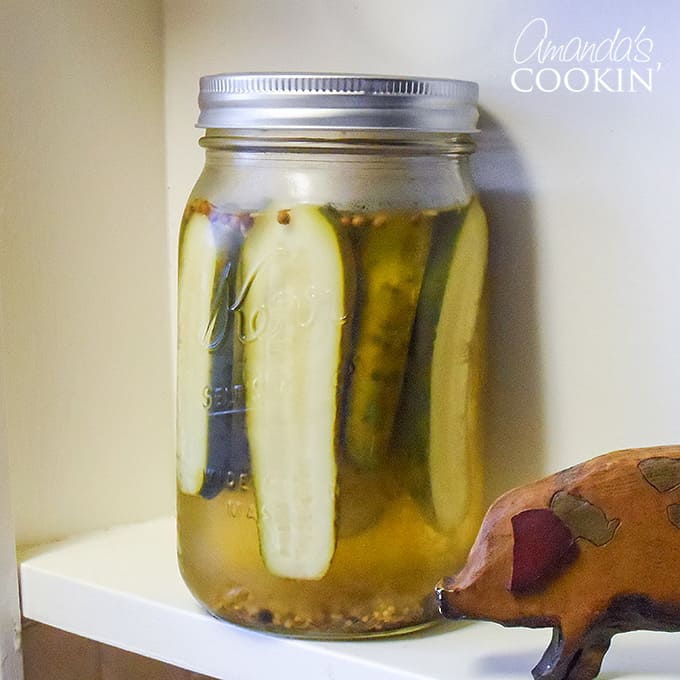
The verdict? Everyone in this house loves them! They aren’t exactly like Claussen, but pretty dang close! Close enough that they get devoured by everyone in this house.
They are actually fun for me to make. So while it would certainly be easier for me to grab a jar of Claussen from the grocery store, and I probably still will now and then, I love making my own.
My first batch was a bit cloudy, and they also had a distinctive mustard flavor. So I cut back the mustard seed in the second batch and I believe we now have a winner. :)
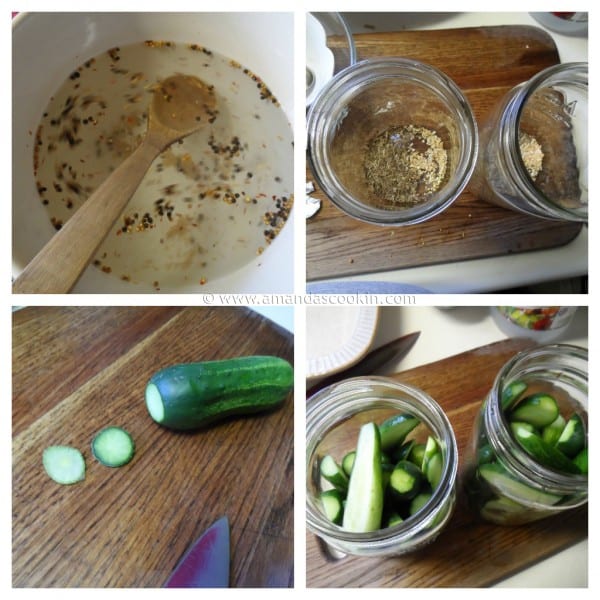
You’ll make the brine first, it’s easiest to do it in a 2-quart pitcher. You’ll see me mixing the brine in a bowl in the picture above. Don’t, it’s an extra step, just use a pitcher. Put the dill seed and dried garlic in the jars.
Now, make sure you give your pickling cucumbers a good rinse, make sure there’s no dirt. Trim the blossom end, I trim both ends, then cut in half lengthwise and distribute in your jars.
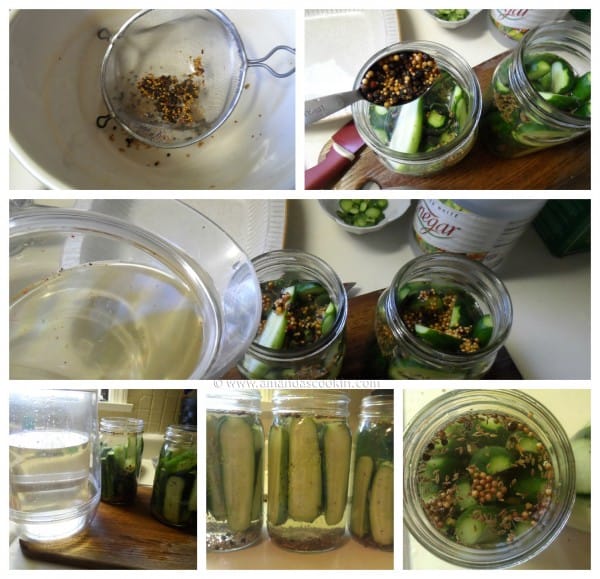
Before adding your brine, strain out the solids. Distribute the solids evenly among the two jars, then add brine. You will have leftover brine that can be discarded when you are all done.
When you perch the kid on your jars, you want air to be able to get in and gases to be able to escape.

I actually put my pickles in one big pot now and then move them to a large covered glass container in the fridge instead of using jars now. Someone in the comments asked for a picture of perching the lid, you can see that above.

This is what they will look like after a day or so. They usually take 2-4 days. My first batch took the full four days while my second batch was ready in two and a half days. I think the difference was that I actually used three jars and they weren’t packed as tightly.
Enjoy – crunch!
Troubleshooting your pickles
Scum or film on top – During your first few days, fermentation takes place. You will probably see bubbles rising to the surface and may see some “scum” forming on the surface. Skim this off and discard. This is a completely normal step in the fermentation process.
White sediment at the bottom of the jar – According to Colorado State University, “A white sediment at the bottom of the jar may be caused by anti-caking agents in the salt or by the fermenting bacteria. Neither cause is harmful.”
According to Colorado State University “…factors that lead to spoilage include failure to remove blossom ends, failure to thoroughly wash products to be pickled, not removing the scum that accumulates on curing brines, using a weak brine or vinegar solution, not keeping the pickles covered with brine throughout the curing process, using deteriorated ingredients such as moldy garlic or decayed spices, or storing the pickles at too warm a temperature.”
You can download the complete PDF document from The Colorado State University here.
Important Tips to Note
The Blossom End
The blossom end of the cucumber (the end opposite from the stem) contains an enzyme that can make your pickles turn mushy. Always cut it off, I cut off both ends for good measure and to keep them uniform.
Vinegar
Use vinegar that has at least 5% acidity. Don’t reduce the vinegar in this recipe.
Salt
Only use pickling salt or coarse (NOT flaky) Kosher salt, though I always use pickling salt. Table salt contains an anti-caking agent that causes the brine to get cloudy. If you use table salt, it’s still safe, but you will have a cloudy jar of pickles with white sediment at the bottom.
Cucumber Types
Use cucumbers that are of the knobby variety, grown specifically for pickling. Check seed catalogs to find the different varieties. Cucumbers with a wax coating are not recommended as the brine will not be able to penetrate them. When selecting cucumbers, be sure that they are firm and not soft.
Wash Your Hands!
It’s tempting to reach in and turn your cucumbers, but please make sure you wash your hands first. Introducing any foreign oil or material from your skin could cause problems with your brine.
When your pickles are all gone, do you pour the pickle juice down the drain? Instead, try these ideas for reusing pickle juice! Looking for a unique recipe to try with your freshly make pickles? Here’s a Grilled Tomato Relish that’s great on burgers and dogs!

This Claussen pickle recipe was originally published here on September 18, 2012
More Related Recipes
- Cucumber Salad
- Sweet Corn and Chickpea Salad
- Grilled Corn and Zucchini Salad
- Pickled Beets
- Pickled Onions
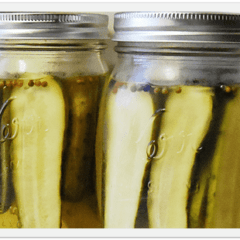
Homemade Claussen Pickles Copycat
IMPORTANT – There are often Frequently Asked Questions within the blog post that you may find helpful. Simply scroll back up to read them!
Print It Rate ItIngredients
- 20-25 small to medium pickling cucumbers
- 2 quarts cold water
- ½ cup white vinegar
- ⅓ cup canning/pickling salt or coarse Kosher salt
- 1 teaspoon coriander seed
- ½ teaspoon mustard seed
- ¼ teaspoon red pepper flakes
- 1 tablespoon black peppercorns
- 1 tablespoon dill seed
- ¼ teaspoon dried garlic
- Fine mesh colander
- 4- cup measuring cup
Instructions
- To make the brine, combine water and vinegar in a large pitcher. Add salt, coriander seed, mustard seed, red pepper flakes and black peppercorns. Stir until salt is dissolved. Set aside.
- Wash cucumbers in water and trim 1/8-inch off of the blossom end of each one. Slice each cucumber in half lengthwise.
- Divide the dill seed and dried garlic evenly between two clean quart sized jars. Fill jars with cucumber halves, fitting as many in as you can, they may be snug!
- Stir brine again to mix ingredients. Place a fine mesh colander over a large bowl or measuring cup. Pour brine through the colander, catching the brine solids in the colander. DO NOT discard!
- NOTE: You will not be able to fit all the water in this measuring cup or in the two jars. The goal here is to save the brine solids and use them, you will be discarding the left over vinegar and water mixture when finished.
- Once all the solids have been removed from the brine, distribute them evenly among the jars. Using the brine liquid in the measuring cup, pour into the jars until all the cucumbers are covered.
- Your brine level should cover your cucumbers and reach the bottom of the jar neck where the twisting begins. The cucumbers will also release some liquid as they brine, so don’t overfill the jar. Discard any remaining brine liquid.
- Cover lightly with a lid perched on top but DO NOT close and seal. Leave on the counter (out of direct sunlight) for 1 day, then move to the refrigerator for 2-3 more days, or until the cucumbers taste like pickles throughout.
- Secure lids on jars and refrigerate for up to six months.
Nutrition
Amanda Davis
Latest posts by Amanda Davis (see all)
- Cauliflower Pizza Crust - January 13, 2025
- Keto Peanut Butter Cookies - January 9, 2025
- Cloud Bread - January 6, 2025

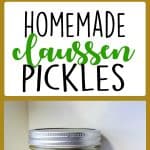
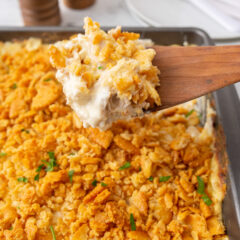
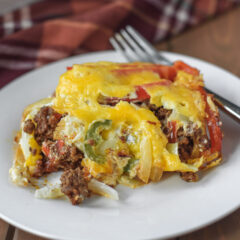




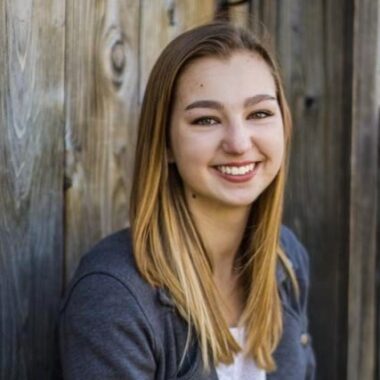
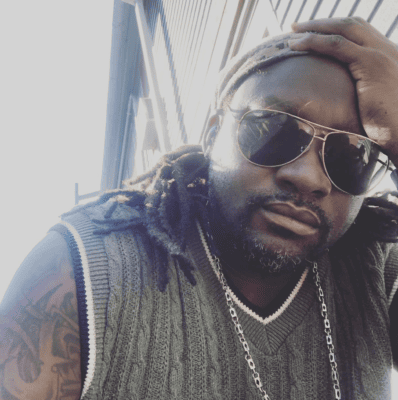

Kim says
Is there a way to can these and keep them crunchy?
Amanda Formaro says
With the heat method? Not really. That’s the difference between refrigerator pickles and canned pickles. The heat takes the crunch out.
Skyler seaton says
Hi I’m new to this! I just tried this recipe and I’m not at the end where you say place lid on top but don’t close and tighten so I’m sorry if this is a dumb question-but does that mean not to put the ring on it just simple to lay the lid ontop and then set aside?
Thank you!!
Amanda Formaro says
Exactly! ;)
cathy says
can i use jarred pickling spice instead of all those separate spices listed ? so–this is not refrigerated??
Amanda Formaro says
Jarred pickling spice has other things in it, so the flavor will be different. You certainly CAN but just know they won’t taste like Claussen :) And no they are not refrigerated right away. You can put them in the fridge, but it will take longer for them to pickle.
Marie Wise-Miu says
This looks like just what I was hoping to find! Claussen pickled aren’t available here. Does have to be in a glass container, or can I use plastic?
Amanda Formaro says
Good question! Should be fine in plastic, I haven’t tried it, but should be fine.
Marie Wise-Miu says
Thanks! :) I did find a nice sized ceramic container. I think I’ll try that.
Karen says
I have never made pickles before, but I buy a lot of Claussen pickles. Do you know if you can save the brine from the Claussen and put new cucumbers in it ? Thanks
Amanda Formaro says
You can – I’ve done it before. It takes a while for them to soak it up, and they won’t be as pungent. But it does work!
Jamie says
Karen, I literally just did this today with beets. My daughter and I LOVE Claussen pickles. Actually the only kind I’ll eat. Amanda is probably right that it will take a while and maybe not work awesome with cucumbers, but you can boil the beets and then put them in the jar while they are still hot. I finished that at 11:00 this morning and my daughter and I are devouring them. Yes, you read that. My 10 year old daughter is devouring BEETS! Can’t wait to see how close this recipe actually matches Claussen because if it does I’ll be pickling everything I can from my garden.
Martin says
Curious what the purpose is for adding some of the seeds/flakes to the brine in step #1, only to filter them out and divide later? Would it make a difference if I make the brine with just the salt, and divide all the other dry ingredients between the two jars up front (saving the step of filtering)?
Amanda Formaro says
No difference at all, you can totally do that!
Janel says
I notice that the recipe calls for 1/2 cup of vinegar to 8 cups of water. Most of the other recipes I’m finding have a much higher ratio of vinegar to water. Is there a typo?
Amanda Formaro says
No typo! it’s true that a lot of pickle recipes use considerably more vinegar. This recipe does not :)
David says
Can I use the same recipe and method for eggs?
Amanda Formaro says
Hmm I don’t see why not. Except I wouldn’t leave them on the counter, I would refrigerate them, which might increase the pickling time.
Just me says
I use this for eggs. I double the vinegar and decrease the water by that much, because I like it. Get a gallon glass container (Target sells them), boil about four dozen eggs, and put it in the fridge. About four days later, you’ve got great pickled eggs, and they keep for months.
Anita Rockey says
My pickles got soggy after just 2 days on the counter. Why? Any ideas?
Amanda Formaro says
Were they near sunlight at all?
Lori says
I’m hoping this will taste as good as Clausen for drinking purposes(Picklebacks) and for brining chicken in for Skillet Pickle Chicken. FINGERS CROSSED and thanks for the recipe!
Sandra mauldin says
What is the point in letting sit on counter a couple of days and not refrigerate after canning. Thank u
Amanda Formaro says
Room temp allows them to “pickle” faster. Remember, you aren’t canning, which is a cooking process.
Julie Nowakowski says
I made these and after 2 1/2 days they taste wonderful! My only question, and I hope it’s not a repeat, but one of the jars of liquid is totally clear but the other is very cloudy throughout and not just a sediment on the bottom. (I wish I could attach a picture). They were on the counter in the same place. The cloudy one doesn’t taste quite as fermented, almost like it’s a day behind. I tasted both and hoped the cloudy ones wouldn’t cause me a problem. Both are good, but don’t taste the same. I used fresh garlic because I couldn’t find garlic flakes. Any thoughts and is the cloudy one still safe?
Amanda Formaro says
Hi Julie! So glad you love them! Usually the cloudiness is from using regular table salt instead of pickling salt. At any rate, they should be totally fine.
From the post:
Only use pickling salt or Kosher salt, though I always use pickling salt. Table salt contains an anti-caking agent that causes the brine to get cloudy. If you use table salt, it’s still safe, but you will have a cloudy jar of pickles with white sediment at the bottom.
Julie says
That’s what’s weird…I bought Ball pickling salt. Oh well, as long as they’re ok to eat it’s all good! I am trying the same recipe with green tomatoes. We’ll see what we get!
Amanda Formaro says
Oh let me know how the tomatoes turn out!
Lee says
I am new to canning. I love the Clausen style pickles but was hoping to can (and not have to refrigerate) large quantities.
If I use this recipe with a pressure canner would it be okay stored at room temperature?
Also would I still have to let it sit out for a few days?
Thanks and excited to try this
Amanda Formaro says
Hi Lee. I’m really sorry, but I am not experienced in canning and cannot give you advice on this. The reason they are crunchy the way that they are is because they are not heated, hence refrigerator pickles.
Chris Natur says
I just made 2 jars of your Claussen Pickle recipe, delucious!!!.
Amanda Formaro says
Yay! So glad you enjoyed them!
Denise says
Can I use a garlic clove as opposed to dried garlic?
Amanda Formaro says
Here is how to calculate that! Garlic Flakes (dehydrated minced garlic): Use 1/2 teaspoon of garlic flakes in place of each clove. Granulated Garlic: Use 1/4 teaspoon of granulated garlic in place of each clove.
Charles Ritchie says
I made these, but after nearly two months in the refrigerator, they just taste like cucumbers (I despise the taste of cucumber). I came back here to revisit and see if I did anything wrong… Sure enough, I missed the part about leaving them on the counter for a couple of days, I put them in the jar an right in the fridge they went. I tried a sip of my brine, it has become flavorless except for the cucumber taste. I put so much work into them, and they’re completely ruined. Is there anything I can do to save them? I feel like if I stuck them on the counter at this point, they would just turn to mush.
Amanda Formaro says
Sorry to hear that! I would try making the brine again and putting the pickles into the new brine in the fridge. Not sure if it will work since the cucumbers have already soaked up the previous brine, but worth a try.
Katie K says
What if I wanted to use whole cucumbers, and not cut them in half? do you think they would still only take 4 days on the counter or longer, would that be even safe to leave the out for longer than 4 days?
Amanda Formaro says
I would do the same amount of time on the counter, but just know that it might take a little longer for the brine to soak completely through the uncut cukes. This will continue to take place in the fridge :)
Max Sigmund says
I thought I’d try to make my own pickles because I didn’t care for those I could buy: they were all too sour, too vinegary. I thought I’d make some using less vinegar, but somewhere in this recipe you say not to use less vinegar. For taste? or because the brine will lose its pickling ability with less vinegar?
Thanks,
Max
Amanda Formaro says
This is the same reason that I sought out a recipe myself as well. I didn’t like how strong many of the recipes out there are. If your cukes are ok in the fridge for a few days, I would suggest making the brine as directed and trying it with a few cucumbers in a small jar. Then taste test and see if it’s to your liking. The flavor profile will change after the first few days as well, but you’ll get the general idea.
Jamie Myers says
I made these on Saturday and they were delicious even before they “pickled”. The brine was perfect. I was so excited for them. Went to check on them today, (3 days later) and every jar had a thin layer of white mold on them. ?. I know I followed the recipe perfectly. The vinegar was 5% and they some how got mold??
I was so upset!! Is there anything I can do? What happened??
Amanda Formaro says
Are you sure it was mold? Here are the first two things that come to mind, this is from the troubleshooting section of the post:
Scum or film on top – During your first few days, fermentation takes place. You will probably see bubbles rising to the surface and may see some “scum” forming on the surface. Skim this off and discard. This is a completely normal step in the fermentation process.
White sediment at the bottom of the jar – According to Colorado State University, “A white sediment at the bottom of the jar may be caused by anti-caking agents in the salt or by the fermenting bacteria. Neither cause is harmful.”
Jen says
Hi Amanda,
I just made these pickles on Saturday. Followed the recipe exactly and when I opened the jars which had been left on my counter to check them today I found the same as Jamie…mold! Both jars had mold and scum. It was definitely mold. Could it be that the recipe needs more vinegar?? Help! Thanks in advance! Jen
Amanda Formaro says
Are you for sure it was mold, like it was black, or was it a white fuzz? Were they on the counter where sunlight could hit them?
Jen says
No, not black. It almost looked like white fuzz/fur!
Amanda Formaro says
That’s not mold. It’s fermentation. Please read the troubleshooting section of the post, it explains it! :)
Melody J Canterberry says
Hi, Amanda. I made this recipe, and the pickles tasted great but came out completely mushy and inedible. Possible that the cukes were old? They were still pretty firm, but had been around for a bit waiting for more to come out of my garden – so that I’d have enough to make a couple of jars.
Also, would it be possible to use the leftover brine to make more? I just feel sort of bad about throwing all that leftover brine out. Could you just use the rest and add more spices to make a few more jars? Thanks.
Amanda Formaro says
Ho Melody, sorry about your pickles being mushy! :( Not sure if it were the cucumbers. I usually keep mine in the fridge before making them, so not sure if that’s what happened.As for using the brine again, I probably wouldn’t. But you COULD try it – I just feel like it might not be as strong the second time around.